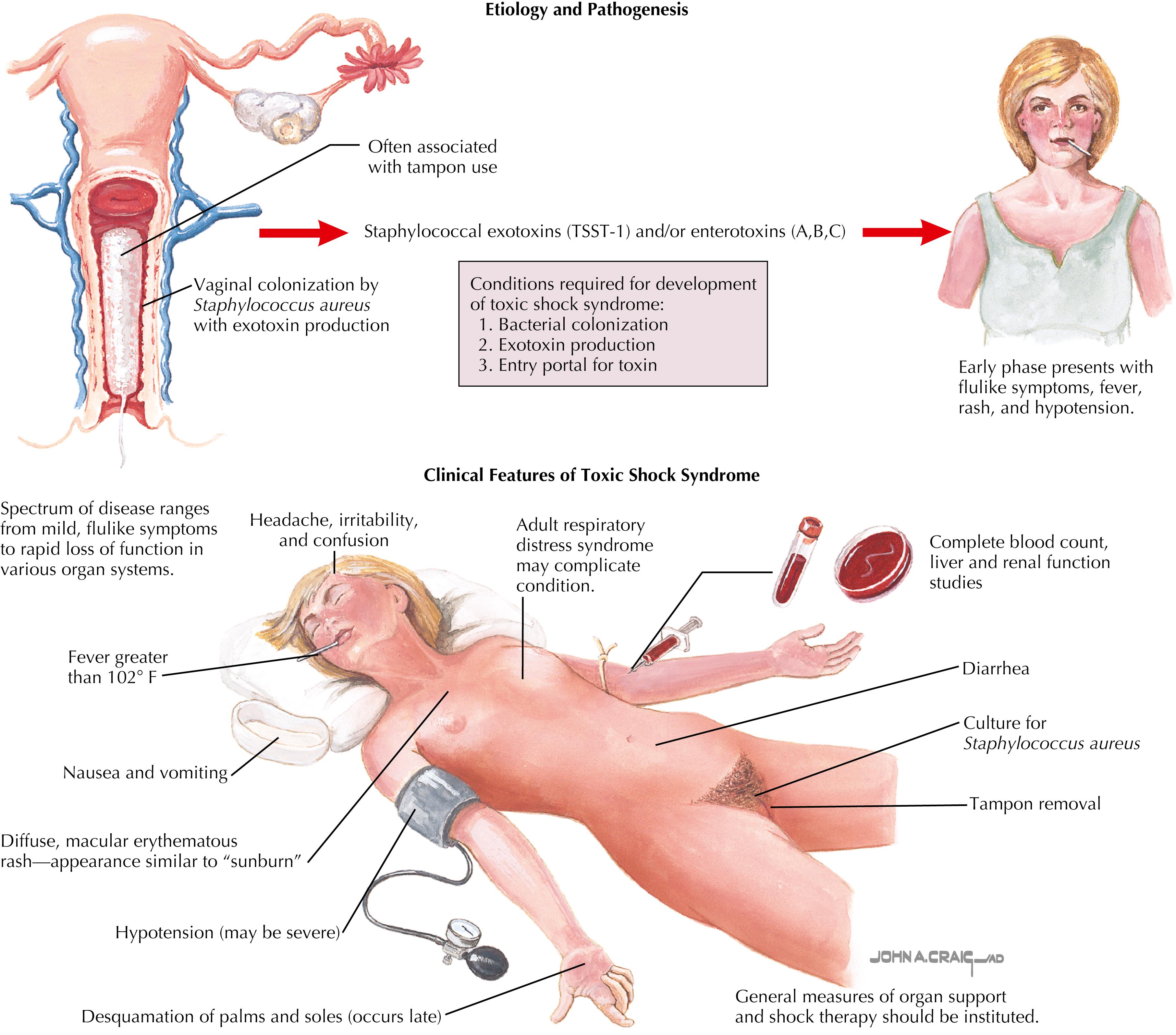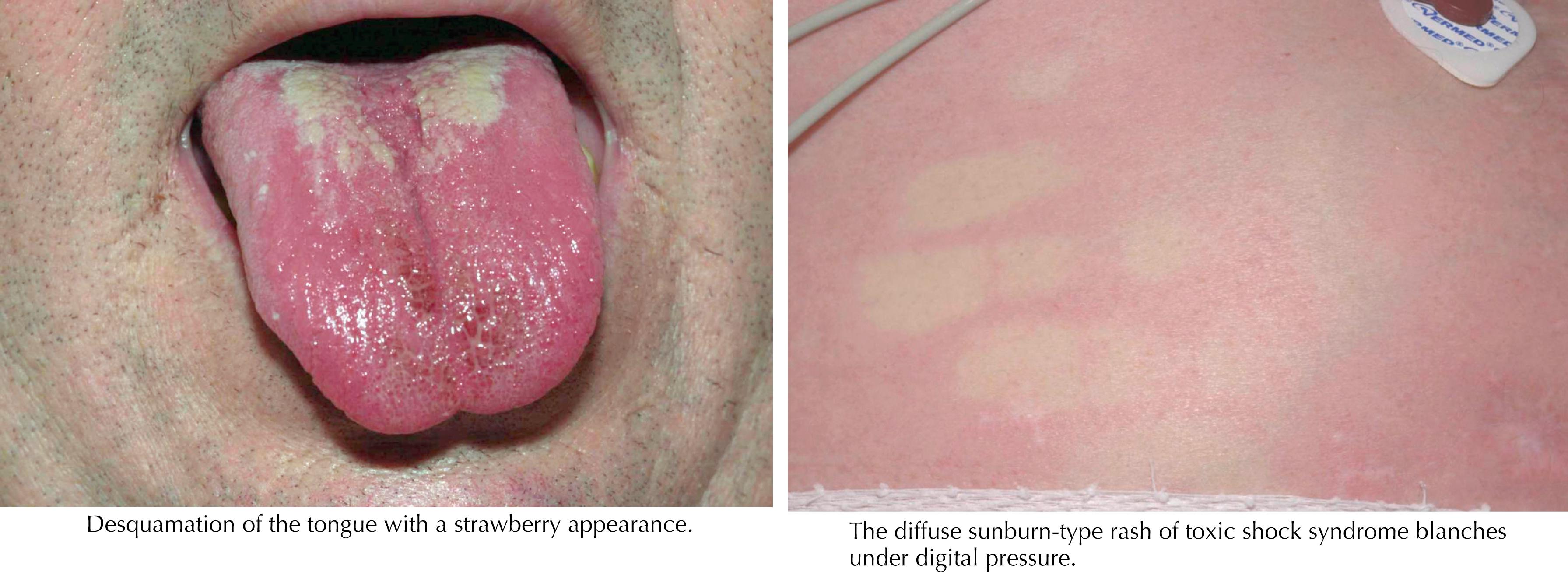Physical Address
304 North Cardinal St.
Dorchester Center, MA 02124
This chapter discusses those soft-tissue infections that are truly life threatening. As such, early clinical recognition is the most important aspect of their clinical management. Staphylococcal and streptococcal toxic shock syndromes (referred to here as StaphTSS and StrepTSS, respectively) have similar clinical features once established, yet their prognosis and management are quite different.
Necrotizing soft-tissue infections occur in three distinct settings. The first, necrotizing fasciitis (NF) type I, occurs when mucosal barriers are breached such that mixed aerobic and anaerobic microbes are leaked into the deep soft tissues, resulting in rapidly progressive necrotizing infections. These infections are usually associated with gas-producing microbes. Surgical inspection of suspicious lesions is paramount, and if necrosis is found, adequate debridement is absolutely necessary.
The second, type II NF, is usually monomicrobic; group A Streptococcus (GAS) is clearly most common, though Vibrio vulnificus , Aeromonas hydrophila , and methicillin-resistant Staphylococcus aureus (MRSA) may also cause extensive soft-tissue necrosis. Surgical intervention is also of major importance and also provides a definitive etiologic diagnosis. These infections are usually not characterized by gas in the tissue.
The third type of necrotizing soft-tissue infection is gas gangrene (also known as clostridial myonecrosis ). This infection is always associated with gas in the tissue and, like other forms of necrotizing soft-tissue infection, is rapidly progressive. Causative organisms include Clostridium perfringens, Clostridium histolyticum, Clostridium septicum, Clostridium novyi, and Clostridium sordellii . All these species are agents of gas gangrene after penetrating trauma; however, the more aerotolerant C. septicum can also cause spontaneous gas gangrene in patients with adenocarcinoma of the colon or neutropenia. C. sordellii and C. novyi have been associated with gas gangrene after skin injection of black tar heroin. C. sordellii has also recently been associated with a toxic shock–like syndrome in women after abortion or childbirth.
A 25-year-old weight lifter strained his trapezius muscle. He had immediate pain and took ibuprofen. After 24 h, the pain subsided but later became severe and he went to an emergency department (ED). He was found to have nausea, a pulse rate of 124 beats/min, blood pressure of 130/65 mm Hg, and oral temperature of 99.3°F. There was no evidence of swelling or erythema around the trapezius although the area was tender to palpation. He was given intravenous morphine and discharged on oral narcotics and ibuprofen. He then developed vomiting, shaking chills, and dizziness. He returned to the ED 18 h later and was found to have a heart rate of 150 beats/min and blood pressure of 120/50 mm Hg. There was massive swelling over the trapezius along with erythema and purple bullae. Lab tests showed a white blood cell (WBC) count of 11,000/mm 3 with 30% bands, 5% metamyelocytes, 4% myelocytes, and a platelet count of 70,000/mm 3 . A serum metabolic panel demonstrated a bicarbonate of 15, creatinine of 2.5 mg/dL, albumin of 2.0 g/dL, and creatine phosphokinase (CPK) of 2500 U/dL. Computed tomography (CT) demonstrated edema extending from the trapezius to the deltoid and pectoralis muscles. Within 2 hrs he developed profound hyotension with evidence of diffuse capillary leak. He remained hypotensive despite the intravenous administration of 10 L of saline and died 30 h after admission.
This is an example of a necrotizing soft-tissue infection and StrepTSS presenting with no portal of entry. Infection begins deep in the muscle at the exact site of injury. There is a trophism of GAS to injured muscle, which is mediated by vimentin. A biphasic pain pattern is usually present; ibuprofen or other nonsteroidal antiinflammatory drugs (NSAIDs) may predispose to worse outcomes. Evidence of renal failure can precede hypotension by several hours. Severe pain is the greatest clue and, because the infection begins deep, the classic signs of a necrotizing process—such as skin sloughing, ecchymosis, and violaceous bullae—may not be present until later in the course. Other clues are a normal or slightly elevated WBC count, but with a dramatic increase in immature cells and a markedly elevated CPK, indicating muscle destruction.
Life-threatening skin and soft-tissue infections are relatively uncommon. Comprehensive epidemiology has been performed only for invasive group A streptococcal infections, including NF. The incidence is approximately 3.5 cases per 100,000 population per year in the United States. Of these, approximately 50% are NF or myonecrosis, of which half are associated with TSS. Before the 1900s, the incidence of malignant scarlet fever was as high as 25 cases per 100,000 population, but it has dramatically declined both in frequency and severity since the advent of antibiotics. Gas gangrene reached epidemic proportions during the Civil War and World Wars I and II; however, antibiotics, rapid transport to evacuation hospitals, and immediate vascular reconstruction have contributed to its declining incidence among active duty military personnel. Mixed aerobic and anaerobic infections are most common in diabetic patients but may also occur after a variety of surgical procedures, such as cholecystectomy, colonic surgery, and gynecologic procedures. Although relatively uncommon, these infections can be devastating and often affect otherwise healthy individuals.
StaphTSS was first reported in 1978; by 1990, more than 3300 cases had been reported in the United States, 90% of which occurred during menstruation in women who were using tampons. A specific toxin, staphylococcal toxic shock syndrome toxin-1 (TSST-1), was implicated in these cases. The incidence of StaphTSS declined precipitously after superabsorbable tampons were withdrawn from the market. Currently, fewer than 100 cases of StaphTSS occur each year, and most of these nonmenstrual cases are nosocomially acquired, often as a result of postoperative staphylococcal wound infections when packing material has been used (e.g., rhinoplasty). It is interesting to note that these cases are associated with strains that produce staphylococcal enterotoxin B (SEB).
StaphTSS is a multisystemic disease with diverse clinical manifestations ( Fig. 21.1 ). A characteristic sunburn-type rash is present in 90% of patients; it is most prominent on the face and trunk and in intertriginous areas. It blanches with digital pressure and is often confused with a drug rash ( Fig. 21.2 , right ). Other early signs of StaphTSS include fever, confusion, nausea, vomiting, diarrhea, tachycardia, and hypotension. Sudden onset and skin rash are the best clues to the diagnosis.


Laboratory tests are helpful to confirm the diagnosis. Leukocytosis with a left shift and thrombocytopenia (with a platelet count of <100,000/mm 3 ) are common findings. Urinalysis may show mild pyuria and, occasionally, microscopic hematuria. Blood urea nitrogen and creatinine levels are elevated in more than 50% of patients. Serum bilirubin and hepatic enzyme levels are raised in about half of patients. Serum creatine kinase levels are high in more than one-third of patients, and myoglobinuria has developed in some patients. Elevated serum amylase levels are also found but may be related to the azotemia rather than to clinically evident pancreatitis. Unexplained marked hypocalcemia is often observed. The drop in serum calcium level is out of proportion to the degree of hypoalbuminuria noted in some patients and may be caused by elevated serum calcitonin levels.
Blood cultures are negative in most cases, but a positive blood culture should not exclude the diagnosis. The original Centers for Disease Control and Prevention (CDC) definition of StaphTSS excluded patients with bacteremia, but it has been shown that some strains that cause bacteremia produce either TSST-1 or SEB. Thus some patients with bacteremia may have more complicated septic shock caused by the presence of these toxin genes. Group A streptococci can produce a severe form of TSS that resembles StaphTSS except for the paucity of cutaneous manifestations and a marked difference in mortality (see the discussion of StrepTSS later and also Table 21.1 ).
| Feature | Staphylococcal | Streptococcal |
|---|---|---|
| Age | 15–35 | 0–80 |
| Severe pain | Rare | Common |
| Hypotension | 100% | 100% |
| Rash | Very common | Less common |
| Renal failure | Common | Common |
| Bacteremia | Low | 60% |
| Tissue necrosis | Rare | Common |
| Risk factors | Tampons, packing | Trauma, varicella |
| Thrombocytopenia | Common | Common |
| Mortality | <3% | 30%–70% |
The management of StaphTSS demands immediate treatment of hypotension and shock with vigorous fluid replacement (and supplemental catecholamines if needed), attention to the site of S. aureus colonization or infection (e.g., removal of packing material, drainage of any abscess), and systemic antimicrobial therapy with an antistaphylococcal agent. Because this infection is commonly associated with a diffuse capillary leak syndrome, administration of 10 to 12 L of normal saline may also be necessary. If the albumin drops below 1.5 g/dL, replacement with colloid rather than crystalloid should be considered. One retrospective analysis of 45 patients suggested that glucocorticoids may assist in recovery, but more data are needed before this can be recommended for all patients with StaphTSS. With proper management and support, most patients recover in 1 to 2 weeks; mortality is less than 5%.
Like StaphTSS, StrepTSS is a toxin-mediated disease. Although multiple exotoxins have been implicated in experimental studies, streptococcal pyrogenic exotoxin type A (SPEA) has been linked epidemiologically. The increased incidence of invasive streptococcal infections may also be linked to the global spread of toxigenic strains of streptococci, particularly M-types 1 and 3, containing the gene for SPEA. Like the staphylococcal toxins TSST-1 and SEB, SPEA enters the circulation and functions as a superantigen, stimulating both lymphocytes and macrophages to produce cytokines that mediate the shock syndrome.
People of all ages are vulnerable to StrepTSS; about half of the patients have diabetes or alcoholism. When a primary focus is identified, it is most often a necrotizing soft-tissue infection; respiratory infections are the next most common focus.
The onset of StrepTSS can be subtle, with fever, chills, nausea, vomiting, and diarrhea for 12 to 36 hours before the sudden onset of hypotension, which occurs in all patients and is often severe. Other clinical features include a generalized erythematous rash (10% of cases), which desquamates 7 to 10 days into the illness, acute respiratory distress syndrome (60% of cases), renal failure (80% of cases), and soft-tissue necrosis, such as NF or myonecrosis (see Table 21.1 ). In patients with NF or myonecrosis, the initial complaint is often severe, unrelenting pain out of proportion to the clinical findings (see the discussion of necrotizing fasciitis, later). In many such cases, infection begins at the site of antecedent trauma that does not break the skin (e.g., muscle strain, bruise). Without a portal of bacterial entry to provide clinical clues, the diagnosis is often missed or delayed, causing mortality in these “cryptic” infections to approach 85%. Further, experimental evidence suggests that administration of nonsteroidal antiinflammatory agents may predispose to worse outcomes in these infections. Laboratory evidence of multiorgan involvement can typically be found and characteristically includes evidence of renal impairment, hepatic abnormalities, and laboratory evidence of disseminated intravascular coagulation, though clinical evidence of coagulopathy is rarely present.
Even after aggressive treatment—including antibiotics, circulatory and respiratory support, and appropriate surgical debridement—mortality rates range from 30% to 70% (see the discussion of streptococcal NF, later, for antibiotic treatment and the use of intravenous immunoglobulin [IGIV]).
Become a Clinical Tree membership for Full access and enjoy Unlimited articles
If you are a member. Log in here